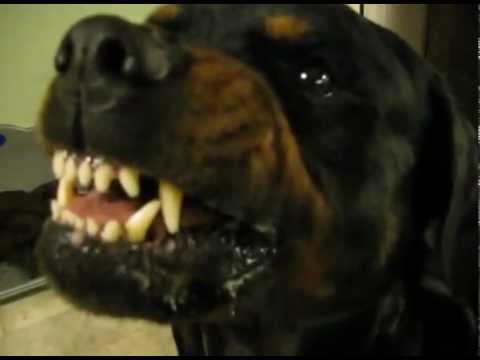
Don’t be fooled though, Rottweilers can make excellent family pets too; they aren’t just great as watchdogs. You just have to make sure you train and exercise your Rottweiler to overcome this breed’s stubbornness and determination. The Rottweiler has a moderate training ability and only needs a moderate amount of exercise; obedience lessons and long walks will do the trick. If a Rottweiler is consistently trained to be friendly and properly interact with non-threatening individuals, this breed will know when to lie back, and when to go in protection mode.
The Rottweiler, originating around Rottweil, Germany, was once used to herd cattle. Cattle herding was then outlawed in this town, which gave the Rottweiler little use and the breed started to slowly dwindle. In the early 1900s, the loss of this breed was acknowledged and Rottweilers were soon revived. Some police departments started to use the Rottweiler out in the field and tax collectors used the breed as well for protection when going house to house collecting money. Now, this breed stands to be one of the United States’ most popular breeds, behind other common breeds like the lab, German Shepherd, Yorkie, Beagle, and Golden Retriever. Along with being one of the most popular breeds, combine one of our most popular dog gifts, our Rottweiler dog socks to make the perfect holiday present.
Rottweilers have a dense, short outer coat. The coat is always black with rust colored markings. The rust colored markings are specifically located; a spot over each eye, around the muzzle, throat, under-tail, legs, and a triangle marking on its chest. This breed tends to be hot a lot so they enjoy cold weather and their short coat helps with keeping them cool. The short coat is sleek and easy to maintain, requiring an occasional brushing. This breeds coat should never be long or wavy. Rottweiler dog key leash racks display the breeds markings and coat accurately.
This breed tends to have a handful of major health concerns. Canine hip and elbow dysplasia, subaortic stenosis, gastric torsion, and osteosarcoma. Several minor health issues are also a concern including osteochodrosis, ectropion, panosteitis, and type III von Willebrand Disease (vWD). vWD is a genetic bleeding disorder that is caused by the dog not having the substance that allows for platelets to form clots. Because of this, a Rottweiler with this disease will have excessive bleeding if they are injured, similar to hemophilia in humans. Other dog breeds, like the German Shepherd, Doberman Pinscher, and Scottish Terrier tend to have a higher occurrence of this disease; this is not as common in Rottweilers.
MUSIC: ZZ-Top – Sharp Dressed Man & La Grange
READ MORE ABOUT ROTTWEILER BREED’S HISTORY AND MORE:
http://www.donnerbergrottweilers.com/rottweiler-history.html
http://www.rescueeverydog.org/rotty_history.html
http://en.wikipedia.org/wiki/Rottweiler
http://vomhausekelleman.com/index.php/rottweiler-breed-information
http://www.akc.org/breeds/rottweiler/history.cfm
http://dogbreedsatoz.com/rottweiler-dog-breed/
